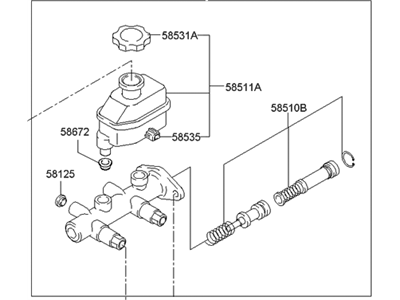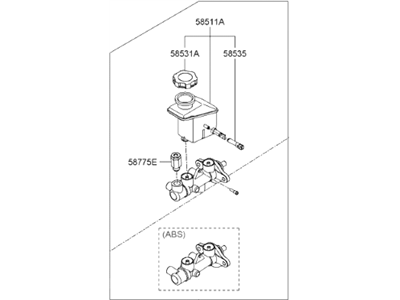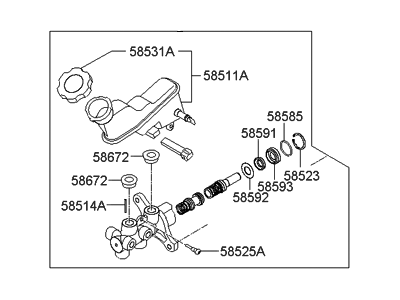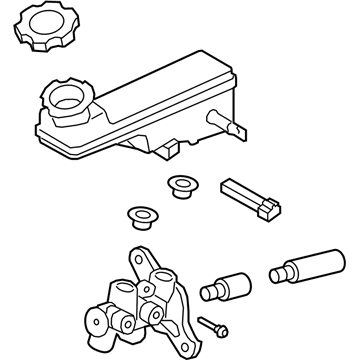×
- Hello
- Login or Register
- Quick Links
- Live Chat
- Track Order
- Parts Availability
- RMA
- Help Center
- Contact Us
- Shop for
- Hyundai Parts
- Hyundai Accessories


My Garage
My Account
Cart
Genuine Hyundai Accent Brake Master Cylinder
- Select Vehicle by Model
- Select Vehicle by VIN
Select Vehicle by Model
orMake
Model
Year
Select Vehicle by VIN
For the most accurate results, select vehicle by your VIN (Vehicle Identification Number).
11 Brake Master Cylinders found
Hyundai Accent Cylinder Assembly-Brake Master
Part Number: 58510-25300$420.22 MSRP: $595.58You Save: $175.36 (30%)Ships in 1-3 Business DaysHyundai Accent Cylinder Assembly-Brake Master
Part Number: 58510-25000$530.11 MSRP: $751.34You Save: $221.23 (30%)Ships in 1-3 Business DaysHyundai Accent Cylinder Assembly-Brake Master
Part Number: 58510-1G000$705.14 MSRP: $1008.26You Save: $303.12 (31%)Ships in 1-3 Business DaysHyundai Accent Cylinder Assembly-Brake Master
Part Number: 58510-1R200$516.86 MSRP: $732.55You Save: $215.69 (30%)Ships in 1-3 Business DaysHyundai Accent Cylinder Assembly-Brake Master
Part Number: 58510-22000$409.69 MSRP: $580.66You Save: $170.97 (30%)Ships in 1-3 Business DaysHyundai Accent Cylinder Assembly-Brake Master
Part Number: 58510-22010$409.69 MSRP: $580.66You Save: $170.97 (30%)Ships in 1-3 Business DaysHyundai Accent Cylinder Assembly-Brake Master
Part Number: 58510-22310$409.69 MSRP: $580.66You Save: $170.97 (30%)Ships in 1-3 Business DaysHyundai Accent Cylinder Assembly-Brake Master
Part Number: 58510-22320$409.69 MSRP: $580.66You Save: $170.97 (30%)Ships in 1-3 Business DaysHyundai Accent Cylinder Assembly-Brake Master
Part Number: 58510-1G100$518.96 MSRP: $735.53You Save: $216.57 (30%)Ships in 1-3 Business DaysHyundai Accent Cylinder Assembly-Brake Master
Part Number: 58510-H9210$264.44 MSRP: $371.53You Save: $107.09 (29%)Ships in 1-3 Business DaysHyundai Accent Cylinder Assembly-Brake Master
Part Number: 58510-H9260$291.87 MSRP: $410.06You Save: $118.19 (29%)Ships in 1-3 Business Days
Hyundai Accent Brake Master Cylinder
Hyundai Accent cars include a Brake Master Cylinder, a hydraulic braking mechanism that is accountable for the transforming the force of the driver's foot into hydraulic pressure. This mechanism works through forcing the fluid to propel thru the system to be able of acting on the slave cylinders which, in his turn, press on the brakes to produce the required friction so as to attain the stopping of the car. Usually master cylinder employs dual circuit with two pistons so if one circuit loses capability the other one is capable of braking. Styles of Brake Master Cylinders that may be used in Hyundai Accent models include the cast iron and aluminum Brake Master Cylinder with an integrated reservoir, and the nylon or plastic type with a reservoir that is located outside the assembly. The major difference appears in the classification by the reservoir, where the integral tends to have a single cap as compared to the external types that are characterized by threaded caps. In the course of its use, problems like leakage or internal failure might develop and this will require constant monitoring and repair for proper functioning of the brake.
If you are looking for affordable high-quality OEM Hyundai Accent Brake Master Cylinder, then you have come to the prime place. Our website provides a large amount of genuine Hyundai Accent Brake Master Cylinder at unbeatable prices. All our parts come backed with the manufacturer's warranty.
Hyundai Accent Brake Master Cylinder Parts Questions & Experts Answers
- Q: How to remove and install a Brake Master Cylinder on Hyundai Accent?A:Before deciding to overhaul the Brake Master Cylinder, it is important to check the availability and cost of a new or factory rebuilt unit, as well as the availability of a rebuild kit. The removal process involves locating the Brake Master Cylinder in the engine compartment and mounting it to the power Brake Booster. To remove the Brake Master Cylinder, start by removing as much fluid as possible from the reservoir using a syringe. Place rags under the fluid fittings and prepare caps or plastic bags to cover the ends of the lines once they are disconnected. Loosen the tube nuts at the ends of the Brake Lines where they enter the Brake Master Cylinder using a flare nut wrench. Pull the brake lines slightly away from the Brake Master Cylinder and plug the ends to prevent contamination. Disconnect the electrical connector at the Brake Master Cylinder and remove the two nuts attaching the Brake Master Cylinder to the power booster. Carefully pull the Brake Master Cylinder off the studs and out of the engine compartment, being cautious not to spill any fluid. The installation process involves bench bleeding the Brake Master Cylinder before installing it. Mount the Brake Master Cylinder in a vise and attach a pair of Brake Master Cylinder bleeder tubes to the outlet ports. Fill the reservoir with the recommended brake fluid and use a large Phillips screwdriver to slowly push the pistons into the Brake Master Cylinder, expelling air from the pressure chamber into the reservoir. Repeat this procedure until no more air bubbles are present. Remove the bleed tubes and install plugs in the open ports to prevent fluid leakage and air from entering. Install the reservoir cap. Install the Brake Master Cylinder over the studs on the power brake booster and tighten the attaching nuts finger tight. Thread the brake line fittings into the Brake Master Cylinder, being careful not to strip the threads. Fully tighten the mounting nuts and brake line fittings. Fill the Brake Master Cylinder reservoir with fluid and bleed the brake system. Test the operation of the brake system carefully before placing the vehicle into normal service.
Related Hyundai Accent Parts
Browse by Year
2022 Brake Master Cylinder 2021 Brake Master Cylinder 2020 Brake Master Cylinder 2019 Brake Master Cylinder 2018 Brake Master Cylinder 2017 Brake Master Cylinder 2016 Brake Master Cylinder 2015 Brake Master Cylinder 2014 Brake Master Cylinder 2013 Brake Master Cylinder 2012 Brake Master Cylinder 2011 Brake Master Cylinder 2010 Brake Master Cylinder 2009 Brake Master Cylinder 2008 Brake Master Cylinder 2007 Brake Master Cylinder 2006 Brake Master Cylinder 2005 Brake Master Cylinder 2004 Brake Master Cylinder 2003 Brake Master Cylinder 2002 Brake Master Cylinder 2001 Brake Master Cylinder 2000 Brake Master Cylinder 1999 Brake Master Cylinder 1998 Brake Master Cylinder 1997 Brake Master Cylinder 1996 Brake Master Cylinder 1995 Brake Master Cylinder 1994 Brake Master Cylinder














